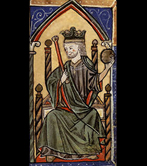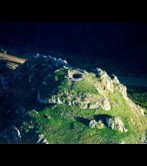Gipuzkoa is incorporated into the kingdom of Castile in 1200
There is almost no information about the incorporation of Gipuzkoa into the kingdom of Castile in 1200, as a result of which there have been many interpretations. Although the argument is usually whether it was a simple conquest or an agreed secession, the subject is in fact more complicated, among other reasons because Gipuzkoa was not a well defined territory and nor was it administratively organized as such. Nor did its inhabitants share common interests, not even among the elites.
Alfonso VIII of Castile incorporated the territory during the siege and conquest of Vitoria and the surrounding area, and therefore, in a climate of warfare, although we can’t say that he invaded Gipuzkoa. Vitoria was founded on the hamlet of Gasteiz by the Navarra monarch Sancho the Wise in 1181, the same king who granted the village charter to San Sebastián, probably a year earlier. The policy of these Navarra villas was, on the one hand, to strengthen contact with Castile (the foundation of the Álava villas of Laguardia, Antoñana, Bernedo, Labraza, Portilla, perhaps Treviño and the Puebla of Arganzón) and, on the other, to gain access to the sea, as Baiona was in the hands of the English. Castile had similar, and therefore conflicting, interests to the Navarrese, both regarding Álava and access to the sea.
Rodrigo Jiménez de Rada, the Archbishop of Toledo, who was Alfonso VIII’s right-hand man (although he was a native of Navarra) says that in 1200 his master took control of Gipuzkoa and, among others, the castles of San Sebastián, Fuenterrabia, Ausa, Ataun and Beloaga. How Alfonso VIII managed to get control of these castles is not known: some may have been taken by force, others may have surrendered or may have been evacuated to reinforce the Vitoria garrison which surrendered to the Castilians after the king of Navarra gave them permission to. That same year, Castile and Navarra signed truces with both parties keeping, with few exceptions, the positions they had occupied during the conflict. In his will, drawn up in 1204, Alfonso VIII appears to express the intention of giving Navarra back the territory occupied during the struggle. This wish was never complied with.
The most controversial question is the collaboration or, at least, the lack of resistance the local lords put up to Alfonso VIII and the occupation agreed under his reign. Nothing was written on the subject at the time and it is first mentioned in the mid-16th century by Esteban de Garibay who tries, viewing as an agreed pact, to describe how the Gipuzcoa fuero regime developed through agreement reached between Gipuzcoan leaders and the king. He develops the theory that a group of lords, offended (for unknown reasons) by the king of Navarra during the invasion of Álava, decided to transfer their loyalty to Castile.
Although it seems contradictory that three centuries later, and as a defence of the fueros (which had developed as a successful alternative to the Parientes Mayores) that such a decision would have been left in the hands of feudal lords, it should be understood that, in the transition from the 12th to the 13th century, only the Donostia elite, a villa that had only existed for 20 years, would have had this political clout. Those who support this view argue that, if it was a voluntary occupation, in the absence of a strong regional administration, Gipuzcoa could not have joined forces with the new king without the full collaboration of local lords and leaders. On the other hand, it is argued that the earlier collaboration with the king of Navarra on the part of Álava and Gipuzcoan leaders, the defection of de Diego López de Haro (whose writ ran in these territories) and the fact that after 1200 some of the castles captured were in Navarra’s control, all contradict the earlier thesis.
What is clear is that, more than the military dynamic, Castile’s control of Gipuzcoa followed the lines of the policy initiated by the kings of Navarra: the promotion of the villas. In 1203, Alfonso founded Hondarribia, which stood on the Bidasoa estuary on the road to Aquitaine, a region that was part of his wife’s dowry. The founding of other maritime villas (Getaria and Mutriku in 1209, Zarautz in 1237) suggests a broader strategy on the part of Castile regarding access to the sea and to western Europe, a strategy which also severely restricted Navarra’s room for manoeuvre. Therefore, if the apparent offence the king of Navarra caused the lords of Gipuzcoa was related to the villas’ privileges – as some have argued – they gained nothing from the triumph of the Castilian cause. This might also explain the later reaction of the Parientes Mayores who tried to put a brake on this development, threatening or offering loyalty to both kings, as circumstances dictated. Nevertheless, it is also possible that this was a later reaction as the foundation of villas spread and Gipuzcoa (and to a lesser extent, Álava and Bizkaia) underwent an enormous process of urbanization, with 25 villas in an area of 2,000 km2.




